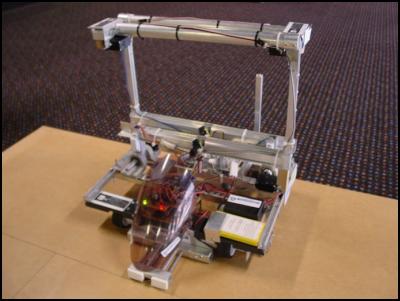University of Auckland Robot wins challenge
University of Auckland celebrates record win at Australasian design competition

Click to enlarge
Media Release
4 October 2006
University of
Auckland celebrates record win at Australasian design
competition
A seed-planting robot designed to beautify ‘Gondwanan’ highways secured first place for the University of Auckland at the Warman Design and Build Competition in Sydney, held to award mechanical engineering excellence.
The Auckland team beat 15 universities from around Australasia to claim the coveted prize. The Mechatronics team comprised students Anatoli Koudriachov (20), Nicholas Wong (20) and Jonathon Platt (20) from the Faculty of Engineering.
Auckland now holds the record number of wins at the annual competition, having clocked up its fourth top placing since 1997.
The competition challenges second year Mechanical Engineering students to design and build a device to solve a practical problem set each year by the organisers, engineering firm Weir Warman.
This year’s challenge, called Project ABC (Autonomously Beautify Countryside), was to design an autonomous device that would accurately and rapidly distribute wild flower seeds along the highways of fictitious planet ‘Gondwana’.
The teams manufactured the prototype device using commonly available materials, components and methods.
The devices competed on a model circuit in Sydney made up of roads, trees and fields. They were scored on speed, damage to the environment and ability to plant the fields, with some fields more difficult to reach than others.
Team Manager and Senior Lecturer in Mechanical Engineering Dr Simon Bickerton says this year’s prototype used clever design techniques, setting it apart from the others.
“Most of the devices were controlled by a programmable microchip, which ours had, but we also had infra-red sensors and a very reliable way of doing a 90degree turn.
“The design was well thought-out and executed by some very bright students, who had the added incentive of really wanting to beat the Australians,” says Dr Bickerton.
The trio acknowledged the support of the Institute of Professional Engineers of New Zealand, who funded two members to travel to Australia. A third member was funded by the Faculty.
Dr Bickerton says the competition is a great practical learning experience.
“At second year level, there are few projects or competitions where students have the opportunity to be involved from the initial rules stage through to concepts, design, construction, and to finally actually test their invention,” Dr Bickerton says.
ENDS


 Little Miracles Trust: 60 Landmarks Light Up Purple To Support Babies Fighting For Life On World Prematurity Day
Little Miracles Trust: 60 Landmarks Light Up Purple To Support Babies Fighting For Life On World Prematurity Day Maia Studio: Frankie Venter Performs With Coldplay At Sold Out Eden Park Show
Maia Studio: Frankie Venter Performs With Coldplay At Sold Out Eden Park Show Royal NZ Ballet: RNZB's Tutus On Tour Returns For Summer 2025
Royal NZ Ballet: RNZB's Tutus On Tour Returns For Summer 2025 Little Miracles Trust: The Little Miracles Trust World Prematurity Day Campaign
Little Miracles Trust: The Little Miracles Trust World Prematurity Day Campaign NZ Society for the Study of Diabetes: Critical Workforce Shortages Leave People With Type 1 Diabetes Unable To Access Life Changing Technology
NZ Society for the Study of Diabetes: Critical Workforce Shortages Leave People With Type 1 Diabetes Unable To Access Life Changing Technology Kindergartens Aotearoa: Kindergartens Aotearoa Opposes Lower Standards For Homebased Services
Kindergartens Aotearoa: Kindergartens Aotearoa Opposes Lower Standards For Homebased Services